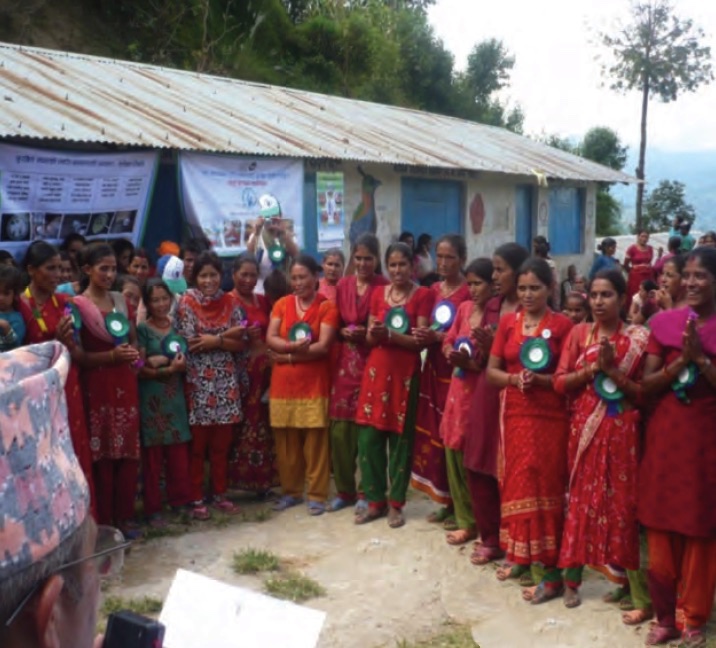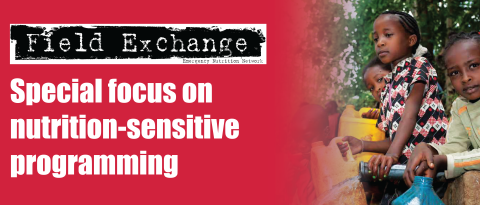Complementary food hygiene: An overlooked opportunity in the WASH, nutrition and health sectors
Summary of research1
Location: Global
What we know: Poor food hygiene may account for a substantial proportion of diarrhoeal diseases and contribute to malnutrition among infants and young children in developing countries.
What this article adds: A recent review highlights that public health interventions have not adequately addressed the food contamination pathway, a risk heightened during the complementary feeding period (6-24 months). Evidenced risk factors for food contamination concern unhygienic food preparation and feeding, and environmental contamination due to lack of sanitation and contaminated water. Three SHARE funded studies are contributing evidence (Bangladesh, Nepal and Gambia); however, major knowledge gaps remain regarding behaviour change, transmission pathways, effects on child health and how to scale up successful interventions. Recommendations include better integration across the nutrition, health and WASH sectors, mainstreaming of food hygiene, and more consistent monitoring and surveillance of complementary food contamination.
 Poor food hygiene may account for a substantial proportion of diarrhoeal diseases among infants and young children in developing countries. However, most of the information on food hygiene in low-income countries derives from expert opinion and biological plausibility rather than robust epidemiological evidence. This briefing paper documents the contribution of Sanitation and Hygiene Applied Research for Equity (SHARE) to narrowing the evidence gap, highlights opportunities for future research, and offers insights that could influence policy and improve programming in the water, sanitation and hygiene (WASH), nutrition and health sectors globally.
Poor food hygiene may account for a substantial proportion of diarrhoeal diseases among infants and young children in developing countries. However, most of the information on food hygiene in low-income countries derives from expert opinion and biological plausibility rather than robust epidemiological evidence. This briefing paper documents the contribution of Sanitation and Hygiene Applied Research for Equity (SHARE) to narrowing the evidence gap, highlights opportunities for future research, and offers insights that could influence policy and improve programming in the water, sanitation and hygiene (WASH), nutrition and health sectors globally.
Diarrhoeal diseases are the second leading cause of death for children under the age of five globally (Liu et al, 2012). Diarrhoeal diseases also increase the risk of malnutrition. While it is important for an infant’s development to complement breastmilk with appropriate solid foods from the age of six months, complementary feeding can provide a key transmission pathway to diarrhoeal disease through unhygienic preparation and feeding of complementary food, which exposes infants to pathogens of faecal origin. This is supported by evidence that the incidence of diarrhoeal disease is higher in children after complementary feeding is initiated (Barrel and Rowland, 1997).
Interventions to improve public health have not adequately addressed this food contamination pathway; although hygiene is high on the WASH sector agenda, interventions have often been limited to hand-washing with soap. The authors suggest that this neglect is down to the prioritising by health institutions of vertical disease-management programmes over horizontally-integrated public health efforts; the greater emphasis placed by the nutrition sector on dietary intake than on food hygiene; the lack of solid evidence on the effect of food hygiene interventions on child health outcomes; and the lack of guidance on best practice for securing sustainable food hygiene behaviour change in various settings.
The authors lay out existing evidence that links unhygienic food preparation and feeding to an increase in the level of microbiological contamination in food and increased risk of diarrhoeal disease. Factors that may lead to food-borne contamination include hot climate, poor storage practices, insufficient cooking time, time elapsed between meal preparation and feeding, and use of unsterilised and dirty feeding bottles for children. There is also some evidence identifying risk factors and associated behaviours including environmental contamination due to lack of sanitation; use of contaminated water to wash serving utensils; not washing hands prior to cooking and feeding; consumption of food that has been spilled on the floor; and use of dirty cloths for wiping hands and utensils. The hygiene practices of mothers have been found to be related to a high level of bacterial contamination of drinking water and complementary foods, and the home has been identified as an important location for acquiring food-borne diseases. Evidence also shows that improving socially or culturally engrained practices is challenging and requires going beyond purely supply-led interventions and addressing structural determinants of hygiene practices.
Clear gaps remain in the literature. In particular, there is a lack of epidemiological studies that characterise pathogen transmission through food and that establish how this differs across settings. There is also a lack of evidence about which factors, or behaviours, pose the greatest risk of food contamination and should therefore be targeted by interventions. In 2010, SHARE provided funding for three studies in Bangladesh, Nepal and the Gambia to plug some of these important evidence gaps. Evidence from the study in Bangladesh showed that food contamination can be reduced using a Hazard Analysis and Critical Control Point (HACCP) methodology at the household level. This is a management system in which food safety is addressed through the analysis and control of biological, chemical, and physical hazards from raw material production, procurement and handling, to manufacturing, distribution and consumption of the finished product (Islam et al, 2013). The study in Nepal, meanwhile, successfully tested a simple and scalable food hygiene intervention targeting multiple behaviours that could be implemented in a community setting through health, WASH and nutrition programmes (Gautam, 2014). Results for the Gambia study will be available in 2015.
Evidence from these studies is already contributing to changes in policy and practice. However, major knowledge gaps remain in the following areas:
Behaviour change: We need clever new ways, informed by socio-ecological approaches to behaviour change, such as those piloted in Nepal, to secure sustainable food hygiene behaviour change.
Transmission pathways: We need to understand fully all the transmission pathways of all of the major enteric pathogens, including through complementary foods, in different settings so as to be able to better target our interventions.
Child health: The effect of food-borne contamination on child health during the critical window of complementary feeding needs to be better understood, in particular the relationship between food-borne pathogens and malnutrition. This would inform policy at national and international level.
Scale up: Further development and testing of strategies for scaling up complementary food hygiene interventions, such as that trialled in Nepal, are also required. Scaling up interventions, and the cross-sectoral collaboration associated therein, would lead to better outcomes for children and would increase the benefits from investment in nutrition, health and WASH.
While our knowledge remains incomplete, the current state of evidence suggests that the successful improvement of safe food hygiene practices can help to reduce or eliminate complementary food contamination, resulting in the prevention or control of diarrhoea and malnutrition. The authors put forward the following recommendations that they suggest will have a major impact on ensuring this:
Food hygiene interventions must be carefully designed based on scientific principles of behaviour change. Evidence from other sectors suggests that simply lecturing and messaging is not effective; programmes that creatively target emotions and the settings in which behaviour takes place are likely to be more successful.
There must be better integration across the nutrition, health and WASH sectors nationally and internationally, and food hygiene should be mainstreamed. Ongoing, post-2015 development discussions provide the perfect setting and crucial range of stakeholders required for such efforts. Guidelines formulated could then be adapted to the national context through a participatory process that engages all relevant stakeholders.
High quality research in this area that addresses identified evidence gaps must continue to be funded and carried out.
There needs to be better, more consistent monitoring and surveillance of complementary food contamination and its causes across the sectors concerned. Joint-sectoral indicators must be established and food hygiene components should be included in demographic health surveys, national-level nutrition plans, health sector information management systems, and ongoing WASH monitoring mechanisms. Furthermore, disease surveillance mechanisms should disaggregate according to the different pathogens that can cause food-borne infection.
Governments, donors and practitioners must increase their financing of complementary food hygiene interventions as these are critical to child health and development.
Financial increases must be accompanied by better targeting and greater efforts to ensure financial absorption. Greater attention must be paid to, and targeting should reflect, the disease epidemiology and transmission pathways of food-borne infections. Furthermore, financial increases should go hand-in-hand with improved budget execution and relevant human resource capacity-building.
Footnotes
1 Guatam, O.P., Esteves Mills, J., Chitty, A. and Curtis, V. (2015). Policy Brief: Complementary Food Hygiene: An overlooked opportunity in the WASH, nutrition and health sectors. March 2015. LSHTM and SHARE.
References
Barrel, R. and M. Rowland. (1997). Infant foods as a potential source of diarrhoeal illness in rural West Africa. Transactions of the Royal Society of Tropical Medicine and Hygiene, 1997(73): pp. 85-89.
Gautam, O., et al. (2014). Effect of an intervention to improve five food hygiene behaviours of mothers in Nepal: an exploratory trial. (in process of submission – not yet published), 2014.
Islam, M., et al. (2013). Hygiene intervention reduces contamination of weaning food in Bangladesh. Tropical Medicine and International Health, March 2013 volume 18 no 3: pp. 250–258.
Lanata, C.F. (2003). Studies of food hygiene and diarrhoeal disease. International Journal of Environmental Health Research, 2003. 13:S1: pp. S175-S183.
Liu, L., et al. (2012). Global, regional, and national causes of child mortality: an updated systematic analysis for 2010 with time trends since 2000. Lancet, October 2012 379(9832): pp. 2151-2161.


